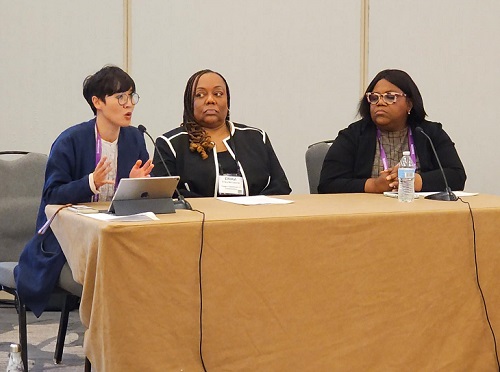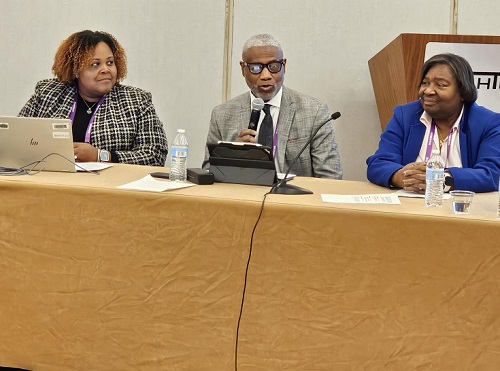How to establish equity more firmly as a core transportation principle was the focus of a knowledge session held at the American Association of State Highway and Transportation Officials 2023 Annual Meeting in Indianapolis.
[Above photo by AASHTO]
Tatum Lau, social value practice lead at consulting firm AECOM and the session’s moderator, noted that transportation infrastructure has the power to “uplift communities and improve lives,” so the focus of infrastructure construction going forward should be building a system that benefits everyone.
“Equity is not the destination,” she noted. “The shared outcome is for the transportation system to generate positive results for all citizens.”
Lester Woods, Jr., chief administrative officer for the Missouri Department of Transportation, added that addressing equity is comparable to running a marathon, not a sprint. “We need to sacrifice effort, time, momentum, and sweat to make this [equity] moment we are engaged in benefit all of our communities,” he said.
Woods noted that, from his perspective, addressing equity in transportation is a leadership challenge.
“We have to stop, look, and listen, but more importantly, we need to respond when it comes to the transportation needs of our communities,” he explained. “You have to embrace the controversy and chaos that comes with the equity discussion, because change does not come without challenges; it is not peaceful. It pushes us to do something different.”

Terri Slaughter, chief equity and inclusion officer for the Michigan Department of Transportation, noted that for her agency, equity is ensuring that transportation is structured in such a way that is right for the next generation – and to do that means equity must be embedded in all aspects of her organization.
“It’s about how we get equity into the planning and development processes, for what goes into our STIP [Statewide Transportation Improvement Program],” Slaughter explained. “The big challenge is defining what transportation equity means – and it is different for every state. What does it mean for us? Answering that means we need to look more granularly at people’s [transportation] needs. And doing that will redefine the very role of the state DOT in transportation projects.”
She added that, “while money does not grow on trees, that is no excuse not to be innovative. This is the time to innovate. We need to address equity from a sustainability perspective – not just about how we establish equity in transportation now but ensuring that it is in place 10 years from now.”
Erika McCalpine, assistant director for social equity at the Oregon Department of Transportation, noted that “living equity out” in every decision a state DOT makes as an organization is not easy, especially in light if the negative history many states have with local communities when it comes to the infrastructure projects of the past.
“We need to recognize the harm we as state DOTs caused communities in the past – destroying economic opportunities, taking property away from families to build highways,” She explained. “To repair and build trust with those communities, we need to talk to the people there and contract with minority-owned businesses working on the projects in those communities.”
McCalpine emphasized that, “This is hard work to do – to go out to a community where you are not welcome. That’s why we need to build bridges for the people for going into these communities. If you truly care about equity, you have to have to hold your people up and hold your leaders accountable. We can’t have people running out into the community supporting equity yet not know what equity means – that also means you need to educate them.”

Gloria Jeff, livability director for the Minnesota Department of Transportation, re-emphasized that equity “is not a singular neat little box” of solutions as transit, railroad, airport, and other transportation infrastructure has all contributed to unequitable outcomes across the country; leading to many communities being overburdened and underserved.
“We now have an opportunity to do things differently,” Jeff said. “We’ve experienced land use changes, and the transportation needs of our communities have changed; so the opportunity for innovation exists.”
She noted that integrating equity into all aspects of the transportation design, planning, and construction process requires hard work and measurement of results. “You get to be wrong, too,” she added. “That’s because, as we are on a journey of exploration with equity, it is OK not to always know the answer.”
For Jeff, the “common idea” regarding transportation equity is that everyone has access to positive outcomes – earning a living, clean air, clean water, access to medical facilities – and not just in urban environments, but across the broad spectrum of community life. “At the end of the day, equity is about ensuring we have positive outcomes as part of everyone’s lives,” she said.
 Nation
Nation
The Stream by AASHTO: Electrified Roadway Testing
December 5, 2025 Nation
Nation

